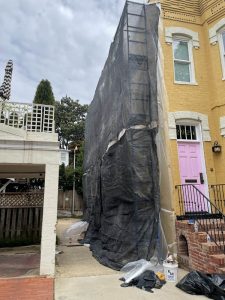Bring In The Best Tuckpointing Contractors in Cathedral Heights
Tuckpointing is a process of repairing and restoring the mortar between the bricks in historic masonry buildings. It is an essential part of preserving these buildings, as it protects against water infiltration, frost damage, and further mortar deterioration. Tuckpointing can also improve the appearance of a building, making it look new again.
If you’re in need of a tuckpointing contractor, look no further than Paragon Remodeling. Whether you need us to repair cracks in your mortar or restore the entire facade of your home, we’ll get the job done right, on time, and within budget. Contact us today for a free consultation!



How Our Cathedral Heights Contractors Handle Tuckpointing
Step 1. Remove mortar joints
The first step in tuckpointing is to remove the old mortar. We usually use an angle grinder, as it is less time-consuming than using a hammer and chisel.
Step 2. Remove dust and debris
Using a masonry brush, we remove the dust and debris from the ground-out mortar joints. If the dust is too thick, we use a high-pressure air nozzle to do the job.
Step 3. Mix new mortar
Once the ground-out mortar joints are already clean, we mix the new mortar to make sure it matches the existing color of the brick.
Step 4. Fill the joints
Once the mortar is ready, we begin to fill the joints with the new mortar. In doing this, we start with the horizontal joints first.
Step 5. Smoothen
After applying the mortar to the joints, we smooth it to achieve a flat-looking surface. Depending on your request, we may also give it a slightly indented look.
Step 6. Make straight lines
When the new mortar starts to harden, we use a straightedge and a tuckpointing tool to make straight lines in the center of the joints. To make it look neat, we make sure that the lines we produce are as straight as possible.
What Our Clients Say About Us
“Paragon’s premier agent was super knowledgeable about the DC metro area and helped me hone in on my dream home in no time. I’ve already referred them to 3 of my colleagues with great feedback.”
— Stacey W.
“While I was looking for tuckpointing contractors online, I came across Paragon Remodeling. Our old house in Washington needed some work to be done and I contacted them immediately. To my surprise, they were very responsive and were able to start working right away. Their contractors were able to finish my tuckpointing job request just in time for my dad’s birthday. Thanks, Paragon Remodeling!.”
— Loretta T.
